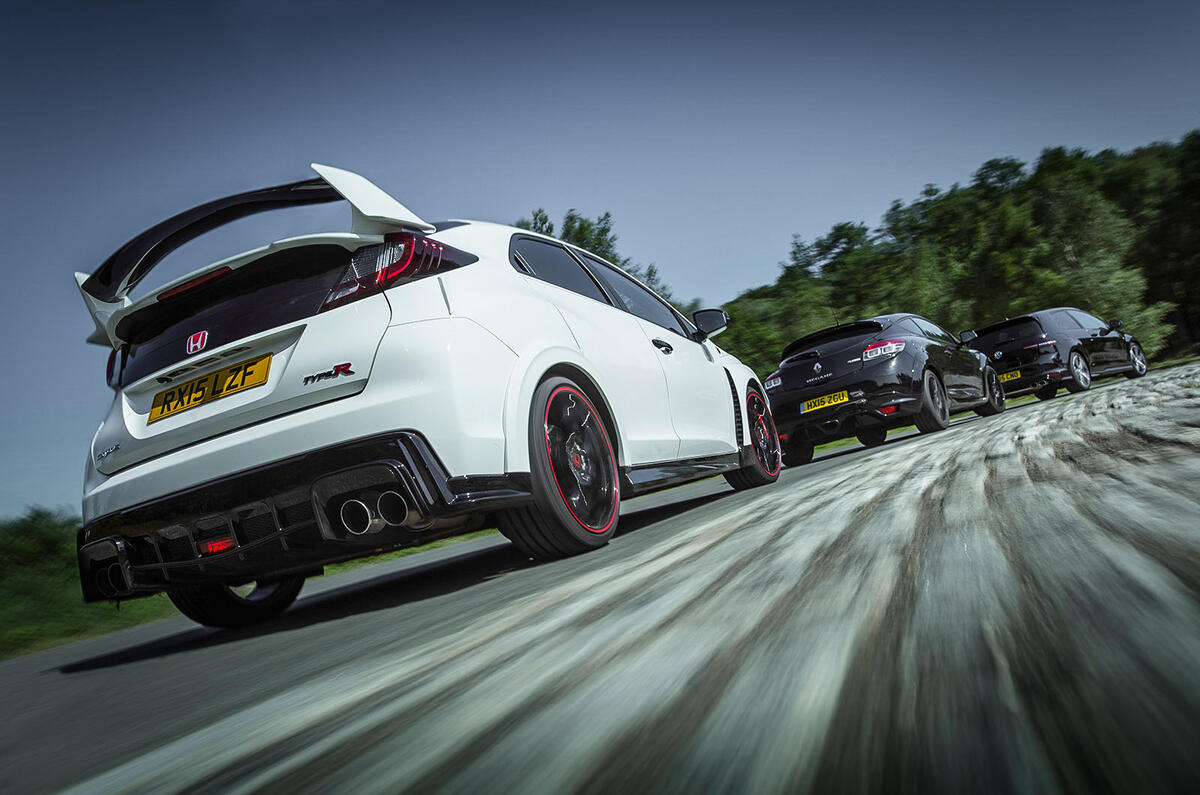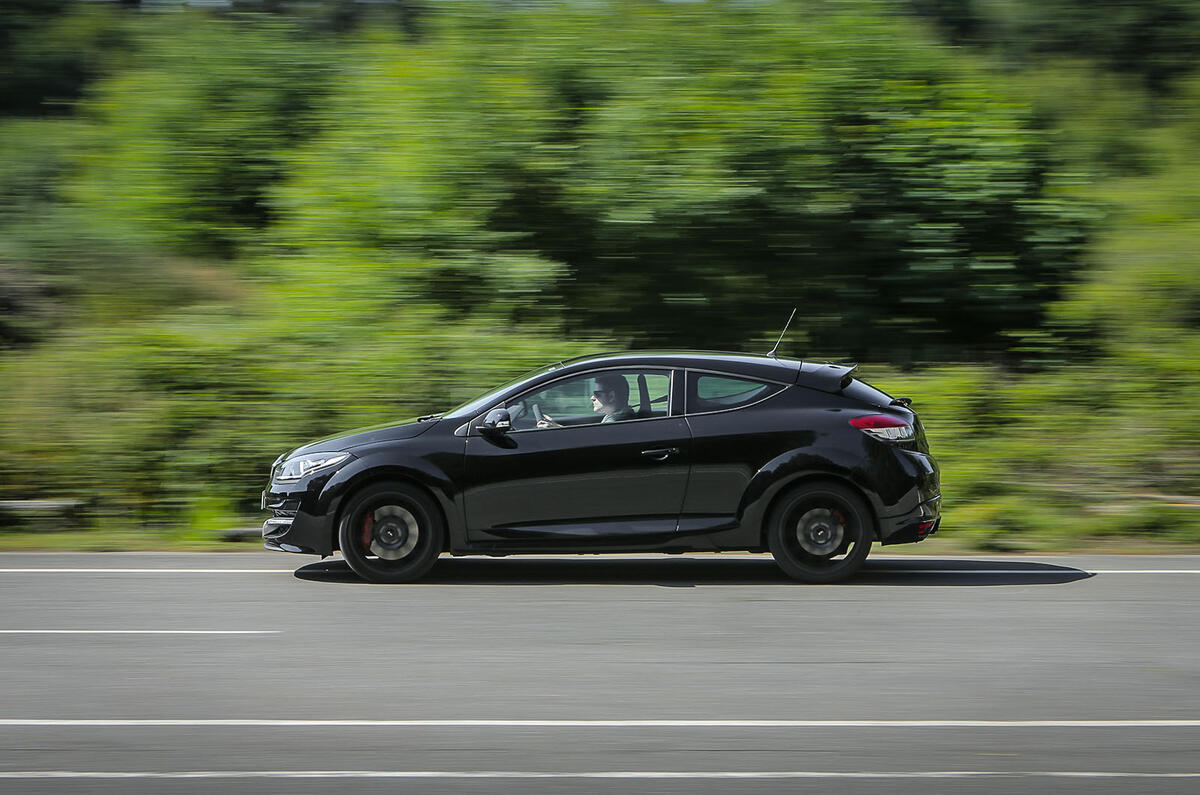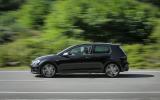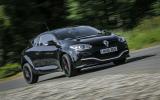Apologies that you join this test while I’m driving the oldest car here, and apologies that you join this test mid-corner.
It’s just pertinent to tell you that I’m driving the Renault Mégane Renaultsport 275 Trophy – do you mind if I variously shorten that name at times? – and its cornering balance is less neutral than I remember.
The Trophy, which is Autocar’s long-term test car, has done a couple of photo shoots on closed circuits and a track day at Spa since it arrived with us a month or so ago. And from inside, it feels like they haven’t been kind to its front tyres.
That’s pertinent, because the Renault’s 271bhp is a hefty amount of power to divert through the front wheels. We’ve thought so before, when a Ford Focus RS we ran needed three tyre changes in 12,000 miles, and I don’t wonder that we will think so again.
The reason it’s pertinent now is because the Renault isn’t even the most powerful front-wheel-drive hot hatchback currently on the block. That accolade now goes to the reason the Renault is on this page at all, which is the arrival of Honda’s new Civic Type R.
Like previous Type Rs, it is front driven. Unlike previous Type Rs, and like the Renault, it comes with a turbocharged 2.0-litre engine rather than the usual Type R solution, namely a high-revving naturally aspirated unit. When even Honda is fitting turbocharged engines to its performance cars, you know turbos are here to stay.
And because Honda was so serious about the new Type R’s track capabilities, particularly around the Nürburgring Nordschleife, it has blessed the car with 35bhp more than the Renault. With 306bhp, that makes it the most powerful front-drive hot hatch currently in production.
Read the Renault Megane RS 275 Trophy first drive review
The Renault is one of the foils for it here, because Renaultsport’s engineers aren’t exactly strangers to the Nürburgring themselves, given that they and the limited-run Mégane Trophy-R held the front-drive production car lap record there until the Honda arrived at the end of the lap four seconds faster (7min 50sec versus 7min 54sec, if you’re interested).
This sort of thing keeps the manufacturers interested after the months they spend chassis tuning and running durability tests there, and it’s not a bad way to measure the relative performance of cars, but it won’t bother us today. Volkswagen’s Golf R is the kind of car that demonstrates why. Volkswagen doesn’t quote a Nürburgring time for the Golf R, yet still we rate it as one of the finest hot hatches ever produced.
Read our thoughts on the Volkswagen Golf R, as we give it a thorough going over
We’ve borrowed a manual version rather than the DSG-equipped car that resides on our long-term test fleet because the other two are manual, although it means that this Golf has three doors like the Renault rather than the Civic’s five.
But marking the Golf out more than that is the fact that it has VW’s 4Motion four-wheel drive system, whose latest generation doesn’t just leave it front driven until the front wheels start to spin up. Instead, it will know to divert power to the rear, too, while you’re turning in to a corner, so that as you begin to accelerate out, you’ll be doing so in a car with rear-biased handling.
Just how rear biased we’ll have to see, but it should be good for the longevity of its front rubber. It also has a positive effect on its standing-start acceleration: the Golf wants 5.3sec to reach 62mph from rest, the Honda 5.7sec and the Renault 6.0sec.
That’s despite the inevitable downside of having four-wheel drive. The Golf’s kerb weight, 1476kg, is a full 100kg heavier than the Renault’s. The Honda is only 6kg heavier than the Renault, at 1382kg. Given that weight penalty, perhaps it’s no surprise that VW isn’t interested in quoting you a ’Ring lap time. (It’s about 8min 15sec, according to the t’interweb.)
What’s more interesting today is what these three are like – not just to drive but also to live with.
That part is the easiest to deal with first, and let’s start with the inside of the Renault, because that’s where we came in and because that has easily the worst interior of the three. It’s a mixed bag inside but, on the whole, the poorest bits are the standard Renault parts – some mediocre materials, awkward ergonomics and an unfathomable infotainment system – and the best bits are the parts that Renaultsport has added, such as the Recaro seats and Alcantara-clad steering wheel.
There are enough sporting highlights to make it feel more special than a standard Mégane, but the Honda goes a stage further again. Partly that’s by adding lots of red, but there’s no denying that its Recaros are mounted well, offering a better driving position for all of our testers, better-spaced pedals and an environment in which it’s easy to feel at home.
The diddy gearknob will remind you of Type Rs of old, and although here, too, there are ergonomic foibles – it’s too easy to obscure the speedo with the steering wheel and if you take less than an hour to find how to disable traffic announcements, you’re a better man than I – it has the measure of the Renault.Not, though, you’ll be unsurprised to learn, the measure of the Volkswagen.
The Golf’s seats are not as supportive as the chairs in the other two, but the driving position, perceived material quality and interior layout are as Volkswagen-like as always. Only a few touches are given over to the fact that this is the most sporting of Golfs – the odd ‘R’ interior tattoo – and otherwise it remains discreet but formal.I suppose it’s much the same on the outside, where the Golf is, no question, the most understated of the three.
Read the full Volkswagen Golf R review
Now, you don’t need me to tell you about these things when you’ve perfectly decent eyes and judgement to see them yourself, but I mention aesthetics for a couple of reasons.
Chief among them is the Civic’s slavishness to aerodynamics. That’s why, Honda says, it has the big splitter on the front and the diffuser on the rear and a spoiler on which – all clichés aside – I have rested a cup of tea. None would be there if it didn’t improve the aerodynamics and generate genuine downforce, says Honda. Even the wing vents direct air out of the engine bay in decent quantities.
And I’ll mention the Renault’s appearance for a couple of reasons. First is the Akrapovic exhaust, which is part of the Trophy pack that makes this car what it is. Second is what takes its price past £30,000: the 19in alloy wheels shod with Michelin Pilot Sport 2 rubber. Which, in the kind of segue that would embarrass the poorest of regional radio disk jockeys, is where we came in.
This test isn’t one of those where we schlep for hundreds of miles to the edge of these islands in search of the perfect sunset. As I write, it is less than 24 hours after the Honda arrived at Autocar Towers and only a few hours before the magazine’s pages are sent to the printers.
So we made the decision to go where we know: some good home counties roads that I know well and a closed test track in Surrey that I know even better.
And within a few minutes, I know it’s the right decision. You don’t see a Welsh sunset, but what I can tell you within 30 seconds of driving, because I’ve driven down this half-mile stretch of twisting B-road simulation thousands of times before, is that this Renault is more front biased than usual, due to slightly worn front rubber.
Yet still, even robbed of some throttle-off adjustability, it retains its extraordinary ability to communicate what it’s doing through the steering, put its power down capably and retain exceptional composure.
The Honda, back to back on the same roads and on this circuit, can’t quite do the same thing. Its steering has more vagueness from straight ahead, and although it torque steers less than the Renault – both have a torque-steer-reducing steering knuckle on their MacPherson strut front suspension – so, too, does it offer less road feel and feedback.
It’s also, despite arriving on completely fresh rubber, no more throttle adjustable than the Renault. Probably less, in fact. There’s an understeer control system on turn-in – which brakes an inside rear wheel to keep things in check and is probably why the Honda feels more agile than the Renault, despite carrying no less weight – but at no point are you aware that you’re doing much more than challenging the front tyres, while the rears follow obediently.
Not that the Civic Type R isn’t fun. It’s so capable that it’s hard to be much else. The brake pedal feel is exceptional, too, and the gearshift is far slicker than the Renault’s.
Read the full Honda Civic Type R review
Neither car has a brilliant engine note, but there’s more induction suck and some exhaust pop in the Renault. Pushing the Honda’s +R button on the dash sharpens the throttle response (as well as firming the dampers by 35% and reducing steering assistance), but it makes the 7000rpm redline no higher nor the note more appealing.For those who come from Type Rs of old, it’s the gearshift and the agility that you’ll note as familiar, not the engine or the steering’s engagement.
Whether the Honda rides with more deftness than the Renault depends on which chassis mode you’ve selected. As standard, it rides more smoothly but with less body control. In +R, it’s harsher than the Mégane and its body is about as tight.
Tuning the Renault’s £2000 adjustable Ohlins dampers is not the work of a button push on the dashboard. As they come, they’re set up brilliantly for fast road or bumpy circuit work. And even on the rubber it’s wearing today, it’s still the most engaging, rewarding, best controlled and most fluid front-driver on the market. More so than the four-wheel-drive car we’ve also got? It is.
The Golf, too, has an adjustable set of dampers (by a button on the dashboard), but whichever setting you place them in, you’re looking at a car that has a more compliant ride yet looser handling than the other two.
It also has the slowest steering, the quietest (if perhaps smoothest) engine and the easiest, entirely notch-free gearshift. The whole Golf R shebang – relatively focused if taken in isolation – feels soft and refined compared with the other two cars here.
Does that matter? Not a jot. Yes, it steers more slowly, its brake pedal moves a little further and the body takes longer to settle into its cornering stance – like a soft-close kitchen drawer rather than a conventional one.
But there’s still raw ability and capability to it. Mid-corner bumps don’t unsettle the Golf, it’s resistant to understeer at all times and, like the Renault, you can do things with it as you turn in, or mid-corner, to shift the balance around. It’s playful without being serious.
Add to that the fact that it’s the one you’d choose if you had to drive 1000 miles, right now, and there’s a compelling case for the Golf R to walk away with the victory here. Sensibly, it should get the win, because it’s the one I’d choose for covering 15,000 miles a year.
The verdict
But this is a hot hatchback test and hot hatchbacks – especially these very hottest ones – are meant to be judged on their ability to entertain. So the Mégane 275 Trophy gets the nod instead. It has all the adjustability and entertainment of the Golf, only with added purpose and agility.
And the new Civic Type R? I like it. It’s enjoyable, goes well, grips strongly and is clearly exceptionally capable on a circuit. There’s merit in the fact that it’s not like other hatches, too.
It occupies a good spot between other hot hatchbacks and does, genuinely, offer something that they don’t. The Type R is a good car in its own right, in isolation, and against the clock there’s no arguing against it. If you can ignore the numbers, though, you’ll enjoy more tangible rewards in the other two cars here.
We put the 306bhp Honda Civic Type R through its paces on the road and track
Read Autocar's previous comparison - Mini John Cooper Works versus Audi S1
Renault Megane RS 275 Trophy
Price £28,930; Engine 4 cyls, 1998cc, turbo, petrol; Power 271bhp at 5500rpm; Torque 266b ft at 3000rpm; Gearbox 6-speed manual; Kerb weight 1376kg; Top speed 158mph; 0-62mph 6.0sec; Economy 37.7mpg; CO2/tax band 174g/km, 29%
Volkswagen Golf R 3dr
Price £30,829; Engine 4 cyls, 1984cc, turbo, petrol; Power 269bhp at 5500rpm; Torque 280lb ft at 1800rpm; Gearbox 6-speed manual; Kerb weight 1476kg; Top speed 155mph; 0-62mph 5.3sec; Economy 39.8mpg; CO2/tax band 165g/km, 28%
Honda Civic Type R
Price £29,995; Engine 4 cyls, 1996cc, turbo, petrol; Power 306bhp at 6500rpm; Torque 295b ft at 2500rpm; Gearbox 6-speed manual; Kerb weight 1382kg; Top speed 167mph; 0-62mph 5.7sec; Economy 38.7mpg; CO2/tax band 170g/km, 29%
Get the latest car news, reviews and galleries from Autocar direct to your inbox every week. Enter your email address below:










































































Join the debate
Add your comment
Waiting for the